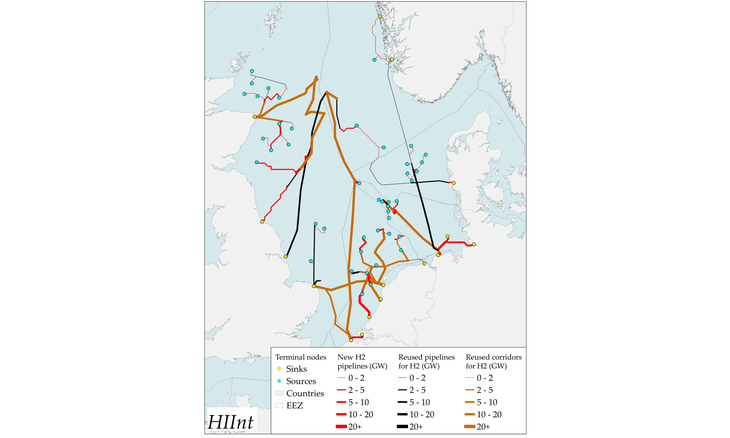Offshore wind energy is exploding in the North Sea in the coming decades from the current 17 GW to over 300 GW by 2050, following the Esbjerg Declaration and national goals. Energy infrastructure will be needed at large scales to bring this vast amount of offshore energy to land, namely through electricity grids and hydrogen networks. However, the North Sea has many competing spatial uses such as protected nature areas, defence areas, and bottom-trawling fishing.
My Masters’ research at Utrecht University, in association with the North Sea Energy programme led by TNO, aimed to design energy networks which transport offshore wind energy to shore to meet a future hydrogen demand. This can be done through offshore production of hydrogen via electrolysis and transport to land via pipelines, or through transport of electricity to land via HVDC cables and production of hydrogen onshore. I investigated the interaction and potentials of spatial complexity, reusing oil & gas infrastructure and interconnection between countries.
Spatial complexity increases the size and costs of energy networks as infrastructure must route around protected areas, as opposed to being connected directly from source to sink in a greenfield approach. For hydrogen pipeline networks, these costs can be reduced by around 40% when reusing oil & gas pipeline infrastructure (see figure below). No such cost savings can be experienced by electricity grids as there is no reuse potential of HVDC cables in the North Sea.

Internationally interconnected hydrogen network (HIInt) scenario. In red, new hydrogen pipelines. In black, reused oil & gas pipelines for hydrogen. In brown, where new hydrogen pipelines are placed next to reused oil & gas pipelines (in the same corridor) due to requiring upgrades in capacity to transport hydrogen.
Reusing oil & gas pipelines is becoming increasingly viable, with recent certifications for 100% hydrogen transport awarded to the Dutch NGT and NOGAT gas pipelines without needing substantial adaptation. Avoiding placing new infrastructure also lowers the spatial footprint, which will become increasingly valuable with the EU Biodiversity Strategy, where the amount of protected sea area needs to increase from 10% to 30% by 2030. To efficiently expand an offshore hydrogen backbone, improved data completeness on offshore oil & gas pipelines is needed on a case by case level. When will they be ready for reuse, how do they need to be adapted, and how much costs will this incur?
From a network-only perspective, offshore hydrogen pipeline networks are much cheaper than offshore electricity grids, due to the high costs of HVDC cable infrastructure. However, from a system perspective, the future differences in costs between offshore hydrogen production (with transportation via offshore pipelines) versus onshore hydrogen production (with transportation via offshore cables) will probably be minimal. The savings made by using pipelines instead of HVDC cables are counteracted with the high costs of offshore platforms for electrolysis, which means that both methods could be cost-competitive, as also seen in recent results from the North Sea Wind Power Hub. Therefore, the conversation of on- or offshore hydrogen production should be case-specific, focusing on other factors such as market dynamics of hydrogen, congestion of onshore electricity grids, need for and location of long-term storage, and available space for electrolysers.
Interconnection of energy networks between North Sea countries can bring benefits such as flexibility, international offshore trading and grid balancing. However, this needs to be planned carefully to avoid unnecessarily high costs and to achieve a balanced sharing of costs and benefits between countries. Acceleration is needed to reach 300 GW of offshore wind, as current projects are too slow. For example, the first Nord Stream pipeline (around 13 GW) and the North Sea Link HVDC cable (1.4 GW between the UK and Norway) took 13 and 12 years to realise, respectively. Marine Spatial Plans (MSP) can be a supportive tool to accelerate this, encouraging harmonisation of offshore activities between countries, such as is done for offshore wind search areas between the Netherlands and Germany. In the future, interconnection could be accelerated by creating broad interconnected energy infrastructure corridors between countries through MSP.
The future energy system in the North Sea region will include a mix of interconnected offshore electricity grids and hydrogen networks, bringing the vast amount of offshore wind energy to shore. Planning of these infrastructures can be accelerated in a calibrated way by expanding the onshore hydrogen backbone to offshore, increasing harmonisation of marine spatial planning between countries, and detailing specific areas for offshore hydrogen production.
Recently I took the opportunity to speak about my Master's research at a UN Global Compact conference on Offshore Renewables Data Sharing for Climate Smart and Resilient Oceans. Here I talked about the importance of accessible, complete, and accurate offshore renewables data to support the energy transition. This blog post summarises my research. For the full report, see the Utrecht University repository, or download it below.
Shape common futures together with us
Get in contact